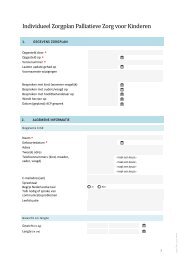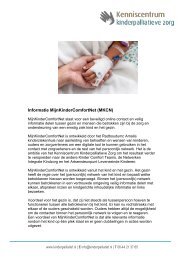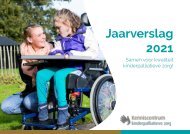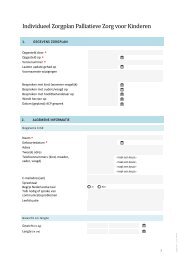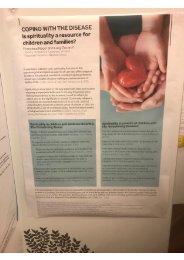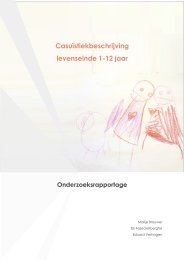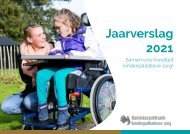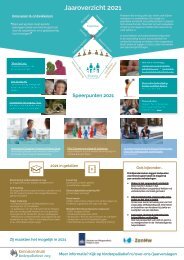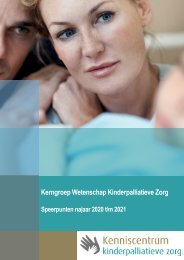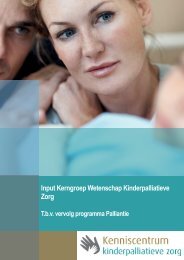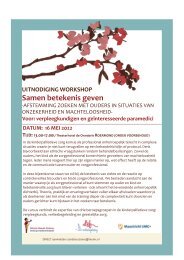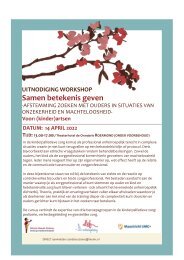Participation in a clinical trial for a child with cancer is burdensome for a minority of children
You also want an ePaper? Increase the reach of your titles
YUMPU automatically turns print PDFs into web optimized ePapers that Google loves.
van der Geest et al.<br />
Parents experiences <strong>of</strong> <strong>cancer</strong> <strong>trial</strong>s<br />
1 (Not <strong>burdensome</strong>)<br />
2<br />
3<br />
4<br />
0 2 4 6 8 10<br />
Number <strong>of</strong> parents<br />
5 (Very <strong>burdensome</strong>)<br />
Figure 1 Child’s burden <strong>of</strong> participation accord<strong>in</strong>g to parents. Burden was scored on a five-po<strong>in</strong>t Likert scale, rang<strong>in</strong>g from one (not <strong>burdensome</strong>) to five (very<br />
<strong>burdensome</strong>).<br />
Table 3 Parents’ motives <strong>for</strong> participat<strong>in</strong>g (aga<strong>in</strong>) <strong>in</strong> a cl<strong>in</strong>ical <strong>trial</strong> (n = 14/17)<br />
Altru<strong>is</strong>m<br />
‘Otherw<strong>is</strong>e successful new treatments will never be d<strong>is</strong>covered’<br />
‘Research <strong>is</strong> very important’<br />
‘Hope <strong>for</strong> a better treatment’<br />
‘Maybe other <strong>child</strong>ren can now be cured’<br />
‘If others had not done the same <strong>in</strong> the past, they wouldn’t be able to<br />
cure as many <strong>child</strong>ren as they do now’<br />
‘[...] and you might be able to prevent others from experienc<strong>in</strong>g th<strong>is</strong><br />
sadness’<br />
‘The type <strong>of</strong> leukaemia was rare, and future patients could benefit from<br />
th<strong>is</strong> research’<br />
‘I still hope <strong>for</strong> cure <strong>for</strong> these <strong>child</strong>ren’<br />
‘As long as the <strong>child</strong> doesn’t suffer any negative consequences it will<br />
help others’<br />
Perceived benefits <strong>for</strong> the <strong>child</strong><br />
‘You want the best <strong>for</strong> your <strong>child</strong>’<br />
‘Prolonged <strong>child</strong>’s life [...].’<br />
Hav<strong>in</strong>g explored all possibilities<br />
‘To pull out all the stops’<br />
‘[...] gave us hope’<br />
‘You want to try everyth<strong>in</strong>g [...]’<br />
Child’s w<strong>is</strong>h to participate<br />
‘Our <strong>child</strong> really wanted th<strong>is</strong>’<br />
fact that the <strong>child</strong> will not survive and m<strong>in</strong>im<strong>is</strong><strong>in</strong>g the<br />
<strong>child</strong>’s suffer<strong>in</strong>g (11). Healthcare pr<strong>of</strong>essionals might help<br />
parents to strike a balance between the benefits <strong>of</strong><br />
participation <strong>in</strong> a cl<strong>in</strong>ical <strong>trial</strong>, but also preserv<strong>in</strong>g the<br />
<strong>child</strong>’s needs and protect<strong>in</strong>g them from severe suffer<strong>in</strong>g<br />
(11,17, 27).<br />
The strength <strong>of</strong> th<strong>is</strong> study <strong>is</strong> that we demonstrated some<br />
new and important contributions, particularly the burden <strong>of</strong><br />
participation and whether or not parents would enrol their<br />
<strong>child</strong> aga<strong>in</strong>, which positively add to the limited <strong>in</strong><strong>for</strong>mation<br />
<strong>in</strong> th<strong>is</strong> field. Th<strong>is</strong> study has several limitations. First, we did<br />
not have any additional <strong>in</strong><strong>for</strong>mation on why some parents<br />
perceived their <strong>child</strong>’s participation as <strong>burdensome</strong> and<br />
whether the burden was physical or psychological <strong>in</strong> nature.<br />
In addition, it <strong>is</strong> possible that <strong>child</strong>ren suffered dur<strong>in</strong>g the<br />
palliative phase, which committed parents to participation<br />
<strong>in</strong> the cl<strong>in</strong>ical <strong>trial</strong>. In addition, caution on the conclusions<br />
that can be drawn <strong>is</strong> important because <strong>of</strong> the limited<br />
sample size, recall bias and the retrospective design. Lastly,<br />
the use <strong>of</strong> a s<strong>in</strong>gle unvalidated Likert scale to measure<br />
parents’ perceived burden <strong>of</strong> cl<strong>in</strong>ical <strong>trial</strong> participation<br />
limits the present study.<br />
In future, there <strong>is</strong> a need to collect <strong>in</strong><strong>for</strong>mation prospectively<br />
be<strong>for</strong>e, dur<strong>in</strong>g and after a cl<strong>in</strong>ical <strong>trial</strong>, <strong>in</strong> order to<br />
support our f<strong>in</strong>d<strong>in</strong>gs, to have a better understand<strong>in</strong>g <strong>of</strong> the<br />
parents’ and <strong>child</strong>’s perspectives, and assure that parents<br />
have real<strong>is</strong>tic expectations <strong>of</strong> what the <strong>trial</strong> might be able to<br />
achieve <strong>for</strong> their <strong>child</strong>. Understand<strong>in</strong>g parents’ reasons <strong>for</strong><br />
not enroll<strong>in</strong>g <strong>in</strong> a cl<strong>in</strong>ical <strong>trial</strong>, and a more <strong>in</strong>-depth<br />
exploration <strong>of</strong> the nature <strong>of</strong> the <strong>child</strong>’s burden would<br />
provide valuable <strong>in</strong><strong>for</strong>mation.<br />
CONCLUSION<br />
The results <strong>of</strong> th<strong>is</strong> retrospective study showed that one-third<br />
<strong>of</strong> <strong>child</strong>ren <strong>with</strong> <strong>in</strong>curable <strong>cancer</strong> <strong>in</strong> our sample participated<br />
<strong>in</strong> a cl<strong>in</strong>ical <strong>trial</strong>. Treatment <strong>for</strong> future patients was the most<br />
frequent rationale reported by parents who decided to enter<br />
a cl<strong>in</strong>ical <strong>trial</strong>, followed by hope <strong>for</strong> a cure and prolongation<br />
<strong>of</strong> the <strong>child</strong>’s life. A m<strong>in</strong>ority <strong>of</strong> parents reported that<br />
participation placed a burden on the <strong>child</strong>. None <strong>of</strong> the<br />
parents would, given the same circumstances, decl<strong>in</strong>e<br />
participation <strong>in</strong> a cl<strong>in</strong>ical <strong>trial</strong>. Per<strong>for</strong>m<strong>in</strong>g cl<strong>in</strong>ical <strong>trial</strong>s,<br />
even <strong>in</strong> a vulnerable population such as <strong>child</strong>ren <strong>with</strong><br />
<strong>cancer</strong> at the end <strong>of</strong> life, may not always lead to <strong>in</strong>creased<br />
burden.<br />
ACKNOWLEDGEMENTS<br />
We would like to thank the mothers <strong>of</strong> the Dutch Childhood<br />
Cancer Parent Organ<strong>is</strong>ation who critically reviewed<br />
the questionnaire about parents’ experiences <strong>of</strong> care dur<strong>in</strong>g<br />
the paediatric palliative phase.<br />
AUTHOR DISCLOSURE STATEMENT<br />
No conflicts <strong>of</strong> <strong>in</strong>terest.<br />
FINANCIAL DISCLOSURE<br />
No specific fund<strong>in</strong>g.<br />
©2016 Foundation Acta Pædiatrica. Publ<strong>is</strong>hed by John Wiley & Sons Ltd 2016 105, pp. 1100–1104 1103




